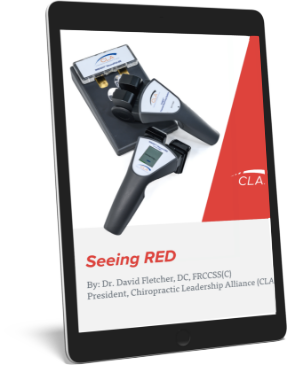By Dr. Christopher Kent
A disturbing trend is the willingness of some chiropractic researchers to abandon chiropractic terminology as well as chiropractic analytical strategies. The generic moniker “spinal manipulation” or “spinal manipulative therapy” is becoming a replacement for the term “chiropractic adjustment.” What’s wrong with that? They aren’t the same thing! There are techniques of chiropractic adjustment, such as basic, Grostic, etc. that simply do not fall under the medical definition of “manipulation.”
A popular definition of “manipulation” is “a manual procedure that involves a directed thrust to move a joint past the physiological range of motion, without exceeding the anatomical limit.” (1) The neurological implications of vertebral subluxation correction are not addressed in this definition.
A grave error is also made in many studies of the effects of “manipulation” by lumping all “hands on” techniques together, while failing to address key issues, such as the examination criteria used to determine the presence of “manipulable lesions,” and how the investigators determine that the “manipulative treatment” was successful.
Would it not be absurd for medicine to test the efficacy of drug therapy for a given disease without defining the diagnostic criteria for the disease and specifying which drug is given and at which dosage? It is no less absurd to collectively refer to all chiropractic adjusting techniques as “manipulative treatments” without defining the technique used, the force applied, the direction of the force, and the criteria for pre- and post-adjustment analysis.
Some researchers, who I will not embarrass by name, acknowledge that the side manipulated in their “studies” is determined by random assignment. Others arbitrarily “manipulate” a vertebral segment whether or not a “manipulable lesion” is present.
Research designs based upon the haphazard application of ill-defined interventions based on unreliable criteria can hardly be considered “scientific.” In his book, “How To Lie With Statistics,” Huff observed: “Permitting statistical treatment and the hypnotic presence of numbers and decimal points to befog causal relationships is little better than superstition…scantier evidence than this– treated in the statistical mill until common sense can no longer penetrate it–has made many a medical fortune and many a medical article in magazines, including professional ones.” (2)
The pain game
A number of chiropractors are also interested in research designs which compare the results of a diagnostic technology to patient symptomatology. The author considers such efforts dubious at best. For example, anatomical imaging modalities do not demonstrate pain. Some have criticized CT, MR, and fluoroscopic studies, claiming that many patients with reported abnormalities are asymptomatic. So what? CT, MR, and fluoroscopic studies simply demonstrate anatomy and pathology — they do not measure symptoms. How could any reasonable clinician expect them to? As has often been stated, “You can’t tell a living patient from a dead patient with an x-ray.”
Similarly, physiologic monitoring devices such as paraspinal EMGs demonstrate functional changes. Does the instrument measure pain? Certainly not. It is a mystery to me why anyone would think otherwise. Why squander our limited resources on research which attempts to correlate these procedures with pain? If a doctor wants to quantitate a patient’s perception of pain, why not use the simple and inexpensive “paper and pencil” tests these researchers are so fond of? Most proponents of these techniques have never claimed a correlation with pain. I am concerned that when it is “discovered” that these techniques do not correlate well with pain, such findings will be used in an attempt to discredit their utility.
Many well-meaning chiropractic researchers are putting the cart before the horse, and employing designs which are inherently flawed. In other instances, the research proposed is clearly designed to sell chiropractic care as a symptomatic treatment for musculoskeletal pain. Chiropractic is not a subset of medicine. Chiropractic is concerned with the detection and correction of vertebral subluxations. The courts and legislatures have, with few exceptions, maintained that chiropractic is not medicine, but is a separate and distinct science. As such, it has different objectives which necessitate different outcome assessments. Chiropractic and medicine share the objective of promoting human health. Their respective strategies for doing so, however, are radically different.
Some might argue that research is research, and that the same designs may be used by all scientists. That is precisely the point. As they say in the computer world, “garbage in — garbage out.” Competent research designs are dependent upon an understanding of the basic sciences, a working knowledge of contemporary analytic procedures, and an understanding of chiropractic philosophy. Appropriate outcome assessments must be employed, based upon an understanding of what the objectives of chiropractic care are. Interventions must be clearly defined. Criteria for the successful (or unsuccessful) application of an intervention must be defined.
What fruit has been borne by the allopathic research programs currently underway? The aberrant perception by students and some chiropractors that chiropractic is a subset of medicine, and that adjusting is a subset of manipulation? The perception that chiropractic care is temporary analgesia at best, and placebo therapy at worst?
The value of chiropractic research lies in its potential to improve our clinical strategies, and to provide us with a scientifically sound basis for making claims to the public and the scientific community. We cannot dismiss meaningful differences in culture and objectives as “just words.”
References
1. Bartol KM: “Osseous manual thrust techniques.” In: Gatterman MI: “Foundations of Chiropractic.” Subluxation. Mosby. St. Louis. 1995.
2. Huff D: “How to Lie With Statistics,” W.W. Norton, New York, NY, 1954.

























































































































































